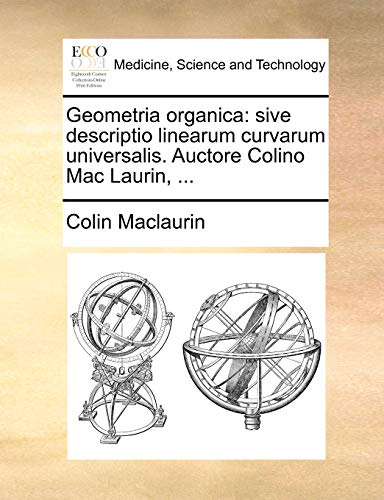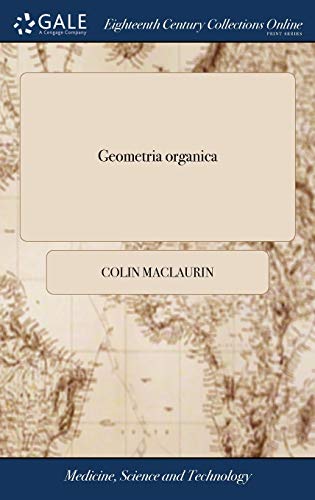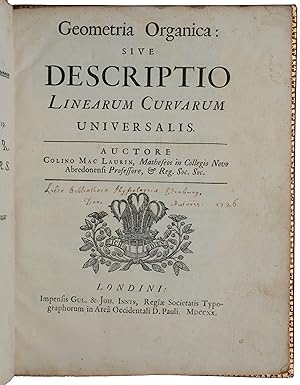Geometria Organica Sive Descriptio (7 results)
Product Type
- All Product Types
- Books (7)
- Magazines & Periodicals
- Comics
- Sheet Music
- Art, Prints & Posters
- Photographs
- Maps
-
Manuscripts &
Paper Collectibles
Condition
Binding
Collectible Attributes
- First Edition (2)
- Signed
- Dust Jacket
- Seller-Supplied Images (3)
- Not Printed On Demand (4)
Free Shipping
Seller Location
Seller Rating
-
Geometria Organica: Sive Descriptio Linearum Curvarum Universalis. Auctore Colino Mac Laurin, . (Latin Edition)
Published by Gale Ecco, Print Editions, 2010
ISBN 10: 1140926349ISBN 13: 9781140926344
Seller: Lucky's Textbooks, Dallas, TX, U.S.A.
Book
Condition: New.
-
Geometria organica sive descriptio linearum curvarum universalis Auctore Colino Mac Laurin,
Published by Gale Ecco, Print Editions, 2010
ISBN 10: 1140926349ISBN 13: 9781140926344
Seller: PBShop.store US, Wood Dale, IL, U.S.A.
Book Print on Demand
PAP. Condition: New. New Book. Shipped from UK. THIS BOOK IS PRINTED ON DEMAND. Established seller since 2000.
-
Geometria organica: Sive descriptio linearum curvarum universalis. Auctore Colino Mac Laurin, . (Latin Edition)
Published by Gale Ecco, Print Editions, 2018
ISBN 10: 1379549124ISBN 13: 9781379549123
Seller: Lucky's Textbooks, Dallas, TX, U.S.A.
Book
Condition: New.
-
Geometria organica; sive Descriptio linearum curvarum universalis [LeatherBound]
Publication Date: 2023
Seller: True World of Books, Delhi, India
Book Print on Demand
LeatherBound. Condition: New. LeatherBound edition. Condition: New. Reprinted from 1720 edition. Leather Binding on Spine and Corners with Golden leaf printing on spine. Bound in genuine leather with Satin ribbon page markers and Spine with raised gilt bands. A perfect gift for your loved ones. NO changes have been made to the original text. This is NOT a retyped or an ocr'd reprint. Illustrations, Index, if any, are included in black and white. Each page is checked manually before printing. As this print on demand book is reprinted from a very old book, there could be some missing or flawed pages, but we always try to make the book as complete as possible. Fold-outs, if any, are not part of the book. If the original book was published in multiple volumes then this reprint is of only one volume, not the whole set. Sewing binding for longer life, where the book block is actually sewn (smythe sewn/section sewn) with thread before binding which results in a more durable type of binding. Pages: 183 Language: Latin.
-
Geometria organica sive descriptio linearum curvarum universalis Auctore Colino Mac Laurin,
Published by Gale Ecco, Print Editions, 2010
ISBN 10: 1140926349ISBN 13: 9781140926344
Seller: PBShop.store UK, Fairford, GLOS, United Kingdom
Book Print on Demand
PAP. Condition: New. New Book. Delivered from our UK warehouse in 4 to 14 business days. THIS BOOK IS PRINTED ON DEMAND. Established seller since 2000.
-
Geometria organica: sive descriptio linearum curvarum universalis
Published by for William and John Innys, London, 1720
First Edition
First edition. EXTENDING NEWTON"S TREATMENT OF HIGHER PLANE CURVES. First edition, very rare in commerce, of Maclaurin's first book, dedicated to Newton and bearing his imprimatur as president of the Royal Society. Maclaurin is best known for his Treatise of Fluxions (1742), "the earliest logical and systematic publication of the Newtonian methods. It stood as a model of rigor until the appearance of Cauchy's Cours d'Analyse in 1821" (DSB). "In 1719 Maclaurin (1698-1746) visited London, where he was well received in the scientific circles of the capital and where he met Newton. On a second visit he met and formed a lasting friendship with Martin Folkes, who became president of the Royal Society in 1741, Maclaurin was meanwhile actively working on his Geometrica organica, which was published in 1720 with Newton's imprimatur. Geometrica organica, sive descriptio linearum curvarum universalis dealt with the general properties of conics and of the higher plane curves. It contained proofs of many important theorems which were to be found, without proof, in Newton's work, as well as a considerable number of others which Maclaurin had discovered while at the university [of Glasgow, which he had entered age 11]. Following traditional geometrical methods, Maclaurin showed that the higher plane curves, the cubic and the quartic, could be described by the rotation of two angles about their vertices. Newton had shown that the conic sections might all be described by the rotation of two angles of fixed size about their vertices S and C as centers of rotation. If the point of intersection of two of the arms lie on a fixed straight line, the intersection of the other two arms will describe a conic section which will pass through S and C" (DSB). "Maclaurin's imagination had been fired by Newton's classic Enumeratio Linearum Curvarum Tertii Ordinis (1704), and by the organic description of the conics given in the Principia (1687); and in his attempt to generalise the latter so as to obtain curves of all possible degrees by a mechanical description he was led to write the Geometria Organica . The treatise is divided into two parts. In the first part the only loci admitted are straight lines along which the vertices of constant angles are made to move. In the second part the curves so found in the first part are added to the loci to obtain curves of higher order. It contains, in particular, the theory of pedals and the epicycloidal generation of curves by rolling one curve upon a congruent curve. A section is devoted to the application to mechanics; and the last section contains some general theorems in curves forming the foundation of the theory of Higher Plane Curves. It also contains what is erroneously termed Cramer's Paradox, the paradox being really Maclaurin's, for Cramer in his Courbes algebriques (1750) expressly quotes the Geometria Organica as his authority" (Tweedie (1916), pp. 89-90). In Part IV of the Geometria organica, Maclaurin treats many applications to mechanics, including problems of centripetal forces and motion in resisting media. ABPC/RBH list five copies in the last 60 years. The 'organic' construction of curves in the title of Maclaurin's book refers to the kinematic generation of curves by continuous motion subject to mechanical constraints. Probably the best known example is the description of an ellipse given in Descartes' Géométrie (1637): if A and B are fixed points and another point X moves in such a way that the sum of the lengths of the line segments AX and BX is constant, then X describes an ellipse (the constraint could be realised by looping a closed piece of string around A and B, and holding a marker X against the string so that it remains taught). "This was an important topic, since in order to determine the point of intersection of curves in the construction of geometrical solutions, it was natural to think of the curves as generated by a continuous motion driven by some instrument. It is the continuity of the motion ge.
-
Geometria organica: sive descriptio linearum curvarum universalis
Published by for William and John Innys, London, 1720
First Edition
First edition. INSCRIBED PRESENTATION COPY. First edition, very rare in commerce, of Maclaurin's first book, dedicated to Newton and bearing his imprimatur as president of the Royal Society; this is a presentation copy, inscribed by Maclaurin. Maclaurin is best known for his Treatise of Fluxions (1742), "the earliest logical and systematic publication of the Newtonian methods. It stood as a model of rigor until the appearance of Cauchy's Cours d'Analyse in 1821" (DSB). "In 1719 Maclaurin (1698-1746) visited London, where he was well received in the scientific circles of the capital and where he met Newton. On a second visit he met and formed a lasting friendship with Martin Folkes, who became president of the Royal Society in 1741, Maclaurin was meanwhile actively working on his Geometrica organica, which was published in 1720 with Newton's imprimatur. Geometrica organica, sive descriptio linearum curvarum universalis dealt with the general properties of conics and of the higher plane curves. It contained proofs of many important theorems which were to be found, without proof, in Newton's work, as well as a considerable number of others which Maclaurin had discovered while at the university [of Glasgow, which he had entered age 11]. Following traditional geometrical methods, Maclaurin showed that the higher plane curves, the cubic and the quartic, could be described by the rotation of two angles about their vertices. Newton had shown that the conic sections might all be described by the rotation of two angles of fixed size about their vertices S and C as centers of rotation. If the point of intersection of two of the arms lie on a fixed straight line, the intersection of the other two arms will describe a conic section which will pass through S and C" (DSB). "Maclaurin's imagination had been fired by Newton's classic Enumeratio Linearum Curvarum Tertii Ordinis (1704), and by the organic description of the conics given in the Principia (1687); and in his attempt to generalise the latter so as to obtain curves of all possible degrees by a mechanical description he was led to write the Geometria Organica . The treatise is divided into two parts. In the first part the only loci admitted are straight lines along which the vertices of constant angles are made to move. In the second part the curves so found in the first part are added to the loci to obtain curves of higher order. It contains, in particular, the theory of pedals and the epicycloidal generation of curves by rolling one curve upon a congruent curve. A section is devoted to the application to mechanics; and the last section contains some general theorems in curves forming the foundation of the theory of Higher Plane Curves. It also contains what is erroneously termed Cramer's Paradox, the paradox being really Maclaurin's, for Cramer in his Courbes algebriques (1750) expressly quotes the Geometria Organica as his authority" (Tweedie (1916), pp. 89-90). In Part IV of the Geometria organica, Maclaurin treats many applications to mechanics, including problems of centripetal forces and motion in resisting media. ABPC/RBH list five copies in the last 60 years (none of them presentation copies). Provenance: Inscribed by Maclaurin on title-page, 'Liber Bibliotheca Physiologica Edinburg. // Dono Autoris, 1726'. From the library of a modern descendant of Maclaurin. The 'organic' construction of curves in the title of Maclaurin's book refers to the kinematic generation of curves by continuous motion subject to mechanical constraints. Probably the best known example is the description of an ellipse given in Descartes' Géométrie (1637): if A and B are fixed points and another point X moves in such a way that the sum of the lengths of the line segments AX and BX is constant, then X describes an ellipse (the constraint could be realised by looping a closed piece of string around A and B, and holding a marker X against the string so that it remains taught). "This was an important topic, since in order.




![Seller image for Geometria organica; sive Descriptio linearum curvarum universalis [LeatherBound] for sale by True World of Books](https://pictures.abebooks.com/inventory/md/md31533286548.jpg)

